Regional Report: MENA

As home to several of the world’s most prolific energy superpowers, the Middle East and North African (MENA) regions have been taking advantage of low prices to meet rising energy demand. Output climbed to a record high this summer, which served as a clear sign of the Organization of Petroleum Exporting Countries’ (OPEC) success in defending market share.
After Iraq, the UAE and Iran boosted output, OPEC production reached in excess of 31 MMbopd for a third month in June, causing the U.S. EIA to express concern related to the region’s record-high inventories, stating that it remains “a threat to the recent stability of oil prices.” Also in June, OPEC re-admitted the Gabonese Republic, which raised the number of members to 14. Thus, the group’s production rate has continued to swell considerably.
It wasn’t until OPEC met in Algiers on Sept. 28 that a plan of action was determined and, as a result of the industry’s unstable markets, member countries elected to cap production at 32.5–33.0 MMbopd.
IRAN
The Islamic Republic of Iran remains a valuable OPEC member, as it was the group’s second-largest oil exporter—until it was overtaken by Iraq in 2012. According to the U.S. EIA, Iran holds the world’s fourth-largest proved crude oil reserves and the second-largest proved reserves, after Russia, making it a global energy giant.
Iran continued its export recovery following the end of international sanctions in January. In an effort to regain lost market share, the country has steadfastly refused to join other OPEC nations in any push to freeze output. Instead, the country has pursued plans to reach pre-sanctions export levels by the end of the summer/early fall.
In April, Iranian production had already risen to 3.56 MMbopd. China has been the primary buyer of that Iranian crude, followed by Europe. Throughout the summer, Iran has sought to rebuild its energy industry and maintain its rising crude sales. Crude and condensate output has exceeded estimates significantly, stirring rumors that the Persian Gulf nation would be willing to join efforts for a freeze in the
near future.
Despite the 25% surge in production, Iran has yet to reach its goal of 4.0 MMbopd by year-end. The country is seeking more than $100 billion of investment from international partners in an effort to fully rehabilitate its oil industry. However, after more than three years of world market absence, companies were hesitant to re-enter the country without in-depth clarification on Iran’s contract model, as well as on any remaining U.S. sanctions.
Foreign investment and technology are essential to Iran’s recovery, as they are needed to boost reservoir pressure to increase capacity at the country’s aging wells. Iran is, however, reportedly seeking to boost output 90,000 bopd this year, from fields in an area west of the Karoun River, along the Iraqi border. The country aims to add about 700,000 bopd from these fields over the next five years.
Other plans for development in the region include Phase 11 of the offshore South Pars natural gas field, as well as oil deposits in Farzad gas field. During the week of Oct. 14-20, the Iranian government has invited international oil companies to submit bids to develop South Azadegan field on the country’s southwestern border, under its new contract model—which was adopted on Aug. 3.
SAUDI ARABIA
Containing roughly one-fifth of the world’s petroleum reserves, and serving as the world’s chief crude exporter, the Kingdom of Saudi Arabia is the leading global energy superpower.
However, despite record production (approximately 10.67 MMbopd in July), Saudi Arabia’s oil inventories have declined progressively. According to analysts, the drop could indicate that the oil market is rebalancing. The country’s new energy minister, Khalid Al-Falih, has communicated the same confidence. “The worst is clearly behind us,” Al-Falih said in June. “We see a balanced market, we see supply and demand converging. We may have started inventory drawdowns that will continue for the foreseeable future.”
Competing against higher-cost shale, Saudi Arabia has made the defense of market share a top priority. Al-Falih—who is also chairman of Saudi Arabian Oil Co.—has been open about maintaining the same policy as his predecessor, Ali al-Naimi. Following his appointment in May, Al-Falih stated, “Saudi Arabia will maintain its stable petroleum policies. We remain committed to maintaining our role in international energy markets and strengthening our position as the world’s most reliable supplier of energy.”
Initially, Saudi Arabia’s willingness to work with fellow OPEC members to resolve the oversupply problem was solely contingent on the participation of its rival, Iran. Iran, however, continued to resist OPEC’s proposal to freeze production, insisting on its right to boost output to pre-sanctions levels. Thus, until an agreement was reached in September, OPEC continued to pump, rather than cut output to lift prices.
As the world’s leading energy supplier, the Saudi economy relies heavily on the oil industry, as roughly 75% of budget revenues and 90% of export earnings come from oil. A new economic plan, promoted by Deputy Crown Prince Mohammed bin Salman, is seeing efforts by the government to lessen that reliance on oil revenue. The plan, identified as Vision 2030, also will see the partial privatization of Saudi Aramco, which will make it the only OPEC nation without full ownership of its national oil company.
Al-Falih said, “There needs to be a fundamental shift in our economic landscape, if we are to reduce our unsustainable over-reliance on oil. Therefore, accelerating reforms across key economic sectors, privatization of key industries and the creation of a globally competitive small- and medium-sized Enterprise sector are essential to delivering Saudi Vision 2030.” The oil minister made it clear in June, however, that investors who buy shares in the company should understand that Saudi Aramco will continue to keep some of its production in reserve.
Meanwhile, E&P operations in the Kingdom have continued to progress. In May, Saudi Aramco completed expansion of its Shaybah oil field, allowing production capacity to rise to 1 MMbopd, from 750,000 bopd. Expansion of the field—which is situated in the Empty Quarter desert, near the UAE border—is helping the state producer maintain its output capacity.
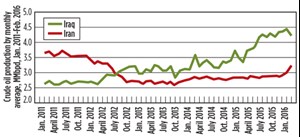
In July, Saudi Aramco reached a significant milestone in its push to expand gas production, as Amin H. Nasser, the company’s president and CEO, signed off on a mega-project aimed at boosting gas production. Ultimately, the $13-billion project will aid efforts to reduce dependence on oil for power generation.
IRAQ
The Republic of Iraq is OPEC’s second-largest producer, and it holds the world’s fifth-largest oil reserves. Like Saudi Arabia, the country was initially prepared to join in a production freeze, but only if other producers committed to the accord, as well. “If some people freeze and others raise, then this is not a good policy,” Iraqi Oil Minister Adel Abdul Mahdi said, a week after the proposal was first announced. “So we have to reach a complete agreement.”
When there was no settlement between OPEC members concerning production earlier this year, Iraqi exports rose, too, Fig. 1. By May, after decades of sanctions, war and little investment, the country’s exports were approaching a record high of 3.365 MMbopd. Overall, Iraq produced a total of 4.31 MMbopd in April.
The country’s southern region holds the majority of its deposits, where fields, including Rumaila and West Qurna, are being developed. Moreover, Kurdish conflict in the northern region of the country had previously prevented exports from travelling via pipeline into Turkey.
Iraq increased shipments again in August, as it agreed to resume exporting from three northern fields in Kirkuk, after exports were halted, due to a payment dispute with the semi-autonomous Kurdistan Regional Government (KRG). Operated by the Northern Oil Co., Baba Gorgor, Jambour and Khabbaz fields reportedly added another 150,000 bopd to exports. Kirkuk’s oil is controlled partially by the central government and partially by the KRG, which is the source of much of the disparity. The discord has been ongoing since 2014.
After agreeing to resume shipments through Kurdish-controlled pipelines, Iraq proposed a formal deal with KRG to ensure that flowrates can be maintained going forward. Jabar al-Luaibi, Iraq’s new oil minister (appointed on Aug. 15) and former head of Iraq’s biggest oil producer, has reportedly expressed a commitment to reaching an understanding and resolving the dispute.
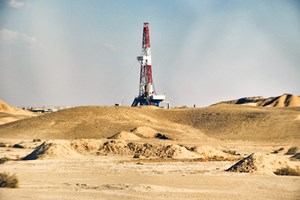
Gazprom Neft Badra, a subsidiary of Gazprom Neft, commissioned its tenth production well at Badra field to the east, near the Iranian border, Fig. 2. The well, P-07, reached free-flow production in July, with output levels of more than 6,500 bopd. The well brought Badra field’s total daily production to 67,000 bopd. Progress at the field is still being made, however, as construction continues. Additionally, the drilling of wells P-10, BD-2, P-14 and P-19 are still underway. Construction is scheduled for completion in early 2017.
KUWAIT
Even with proved oil reserves above 100 Bbbl, Kuwait also has felt the encumbrance of low prices. It joined other Gulf states in January 2016, in the effort to lower government spending and gear up for a prolonged glut. The plan incorporated a 1.6% cut in spending for the fiscal year, beginning in April 2016.
Despite a cut in spending, Kuwait is striving to boost production rates, as well. The state is aiming to reach 3.165 MMbopd by year-end, or early 2017—nearly full capacity. This is up from an estimated 3 MMbopd in April 2016. Kuwait Oil Co. CEO Jamal Jaafar said that the company is “trying to make use of the low cost of production in Kuwait.”
A labor strike took place in April, however, slashing output by an astounding 60%. Kuwaiti oil workers protested reductions in pay and benefits—cuts which were implemented to cope with falling prices—for three days, while government officials refused to negotiate.
After demonstrating the importance of their role in the state’s economy during the three-day walkout, employees returned to work and the state pursued a full recovery from the loss of about 1.7 MMbopd, which surpassed global surplus. Production in northern Kuwait returned to normal within days, and Kuwait Petroleum Corp. (KPC) resumed operations in the country’s southeast, which helped increase overall output.
BP had partnered with KPC in March, signing a framework agreement to explore future investment opportunities in Kuwait. Kuwait Oil Co. (KOC), too, has taken steps to move forward in the development of Kuwaiti resources. The company announced in April that it would soon offer contracts for offshore rigs and support services to drill its first under-sea wells.
Also, to begin this year, Kuwait partnered with Royal Dutch Shell on a project that will see the capture of carbon dioxide at oil fields to be re-injected underground, producing more crude. KOC is testing the injection of chemicals and polymers at fields in the state’s northern region, in an attempt to enhance recovery and further increase production capacity.
Another KOC project is a manifold group trunkline (MGT) system in North Kuwait. The $780-million project is a fundamental part of the company’s plans to increase production in the next few years. Three new gathering centers are already under construction, and the project is scheduled to be complete by the end of 2017.
EGYPT
The largest oil producer that is not an OPEC member, and is the most populous Arab nation, Egypt has seen significant industry advancement, despite the downturn. The Arab Republic of Egypt’s energy sector has been flourishing, particularly in the deep waters of the Mediterranean.
Eni discovered super-giant Zohr field in August 2015, in the Nile Delta region’s Abu Madi West license. Initial estimates indicated that the field was holding approximately 30 Tcf of gas. Eni’s historical find is recognized as a “game changer” for Egypt’s energy supply, as the country has been faced with energy deficits over the last several years. Consequently, Egypt had ceased all gas exports. Expected to come online by 2018, the deepwater Zohr discovery is considered the largest gas find in the Mediterranean Sea.
In February 2016, Eni completed drilling of the Zohr-2 well, the first appraisal well of the Zohr discovery. The well, situated in the Shorouk Block, is about 1.0 mi southeast of Zohr-1. In a water depth of 4,800 ft, the appraisal well was drilled to 13,684 ft and encountered 1,614 ft of continuous hydrocarbon column in a carbonate sequence, with excellent reservoir characteristics—1,000 ft of net pay. The company’s appraisal plan consists of drilling three further wells to fully demarcate the field.
Eni (50% stake), with BP Egypt (50%), made another important gas discovery in May, in the Baltim South Development lease, also in the East Nile Delta. Drilled in a water depth of 82 ft, the Baltim SW-1 exploration well reached a TD of 12,303 ft, and encountered approximately 205 ft of net gas pay in high-quality Messinian sandstone.
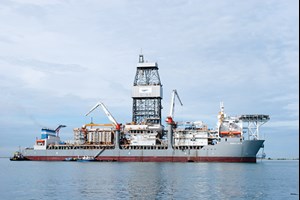
BP announced the discovery of Atoll in March 2015, and has since made significant progress in its development. The Atoll-1 deepwater exploration well—found about 50 mi north of Damietta City—had been drilled using the Maersk Discoverer semisubmersible, in a water depth of 3,028 ft. It reached a depth of 20,997 ft and encountered about 165 ft of gas pay in high-quality sandstones.
Atoll Phase One is now reportedly in an early production scheme, related to the recompletion of the exploration well as a production well, as well as the drilling of two additional wells and the installation of tie-ins. The wells are being drilled by Ensco’s DS-6 rig (Fig. 3), which arrived in Egypt, in May.
The increase in Egyptian E&P activity has caught the eye of companies, including Apache Corp. and Royal Dutch Shell. Their JV in Egypt’s Western Desert reportedly made plans to begin production of unconventional gas back in June. Shell is the unconventional gas pilot project’s operator, with a 52% interest; Apache retains the remaining 48%. Full development of the field—which lies in Egypt’s Northeast Abu Gharadig licensing area (partially owned by state-run Egyptian General Petroleum Corp.)—will have to be negotiated with government officials.
QATAR/UAE/OMAN
With proved gas reserves among the highest worldwide, the energy industry in Qatar has made it one of the fastest-growing and highest per-capita income countries in the world. Though it is OPEC’s smallest member territorially, it is the leading exporter of LNG.
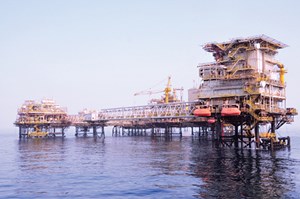
One of Qatar’s major projects is the Bul Hanine redevelopment project, which is aimed at doubling the offshore field’s production rate, Fig. 4. To accomplish this, NOC Qatar Petroleum has announced plans to drill an additional 150 wells through 2028. The replacement and upgrade of existing offshore production facilities—as well as the development of a new onshore natural gas-to-liquids processing plant in Mesaieed—is included in the project plans.
Moreover, Qatar’s biggest offshore oil field, Al-Shaheen, received operator bids in May. The field is approximately 50 mi north of Ras Laffan, and includes 30 platforms and 300 wells. Presently, it is producing about 300,000 bopd and accounts for nearly half of the country’s daily output. Bidders included leading industry players, including Chevron, Royal Dutch Shell, Total, ConocoPhillips and Maersk Oil Qatar. The latter firm has been the field’s operator since 1992; however, its contract with Qatar Petroleum ends in mid-2017.
Total was granted a 30% interest in Al-Shaheen field in June. The agreement covers a 30% interest in the field for a period of 25 years, beginning July 14, 2017. Qatar Petroleum will reportedly retain the remaining 70%.
The United Arab Emirates (UAE), OPEC’s fourth-largest producer, were collectively pumping 2.98 MMbopd in February and, according to the country’s energy minister, were already willing to participate in the proposed production freeze. “It’s logical for everyone to freeze their production,” Energy Minister Suhail Al Mazrouei said. “It doesn’t make sense for anyone to increase production at the current prices.”
Just months prior, however, the UAE had announced plans to boost production capacity to 3.5 MMbopd by 2019. State-run Abu Dhabi National Oil Co. continued to invest in energy projects, despite low prices. Al Mazrouei explained that the country was attempting to reduce its reliance on natural gas for power, while still ramping up imports of the fuel.
One significant project in Sharjah’s Western Offshore Concession, about 22 mi off the coasts of Sharjah and Ajman, is Zora gas field. With a 100% interest in the field, Dana Gas is the operator responsible for all gas sales and purchase agreements. The company announced in February that the field had begun sales gas production, and is expected to achieve a flowrate of 40 MMcfgd.
The Sultanate of Oman reached its highest level of crude and condensate production, ever, in July 2015, exceeding 1 MMbpd. Although it is the biggest non-OPEC producer in the Middle East, the country has been struggling to reverse a long-lasting decline in output since 2008. Through new discoveries and innovative technologies, production climbed by more than 250,000 bopd between 2007 and 2014.
In November 2015, Petroleum Development Oman (PDO) and GlassPoint Solar made significant progress at the Miraah project, as site preparation and grading began a month ahead of schedule. Positioned at Amal field in Oman’s southern region, Miraah is a solar project that will employ energy from the sun to produce steam used in heavy oil production.
According to PDO, the project is an innovative solution to reducing energy consumption and the cost of developing heavy oil. One of the world’s largest solar plants, Miraah is expected to generate more than one GW of solar thermal energy at its peak.
To allow a second phase of development at the Khazzan tight gas field, subsequently accessing additional resources in Block 61, BP (operator, 60%) and Oman Oil (40%) agreed to amend the block’s E&P Sharing Agreement (EPSA) and extend the license area in February. Under the EPSA, the extension added an additional 1,000 km2 or so to the south and west of the original block.
BP CEO Bob Dudley said, “Khazzan is a major resource, with the potential to produce gas for Oman for decades.” The reservoir is one of the region’s largest unconventional tight gas accumulations. With Phase One scheduled to deliver first gas in late 2017, combined production from Phases One and Two is expected to reach approximately 1.5 Bcfgd through development of 10.5 Tcf of recoverable resources. This is equal to about 40% of the country’s total domestic gas production.
DNO’s Hayan-1 exploration well, in Block 36, was not as successful. In May, the company reported that the wildcat failed to encounter hydrocarbons, apart from minor gas signs. Drilled in the Rub al-Khali basin in the country’s southwestern region, the well reached a TD of 11,463 ft and entered three reservoirs, two of which showed good reservoir quality. According to DNO, information amassed from the plugged-and-abandoned well will be used to further evaluate the block.
LIBYA/TUNISIA/ALGERIA
Although it purportedly holds Africa’s largest proven oil reserves, the state of Libya is presently the smallest OPEC producer. This is a result of ceaseless violence and disruption at oil ports and fields throughout the nation. Over the last three years, Libya has lost approximately $60 billion in production and exports.
Libya has been striving to re-establish production rates, and the divided nation reportedly has plans to increase production five-fold, to 2 MMbopd by 2020. However, with political disparity raging in the country’s western region, onshore crude output is battling to keep pace. Output has fallen more than 80% since the 2011 rebellion, which ended the late ruler Muammar Gaddafi’s 42-year reign, and multiple ports—tantamount to about 860,000 bpd in crude exporting capacity—were shut down entirely during the political strife.
In November 2015, Libya’s National Oil Corp. (NOC) announced plans to resume production from southwestern Sharara field—the country’s largest field—after more than a year. Soon thereafter, agreements were made following a peace deal between rival parties, allowing companies to sell crude from fields, including Mesla and Sarir.
Nevertheless, hostility among Libyan factions has continued. After a previous attack in October 2015 that killed a guard, Islamic militants made a second attack on an oil tank in the country’s largest oil port in January. An NOC statement made a plea for help concerning the assault on its resources, asserting, “We are helpless and not being able to do anything against this deliberate destruction on the oil installations … National Oil Corporation urges all faithful and honorable people of this homeland to hurry, to rescue what is left from our resources before it is too late.”
Contending administrations agreed to resume exports from the eastern port of Hariga in May, in a united effort to revive the nation’s production. Nagi Elagrabi, NOC’s east chairman, said, “We agreed to keep the National Oil Corp. neutral, away from political conflicts.” In July, exports also resumed from two of Libya’s biggest oil ports, Es Sider and Ras Lanuf, which had been closed since 2014. The reopening of the ports of Brega and Zuwetina followed. By the end of September, Libya had boosted production more than 70% since August.
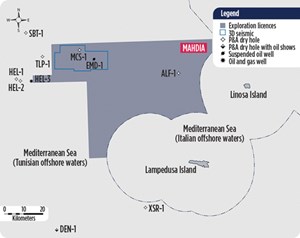
In neighboring Tunisia, Eni has made exploration progress in the Sahara desert, approximately 435 mi south of Tunis. It’s Laarich East-1 discovery well, in the Makhrouga-Laarich-Debbech license, reached a TD of 13,486 ft in September. Hydrocarbons were discovered in sandstone layers of Silurian and Ordovician age. The company performed production tests that revealed a capacity of about 2,000 bopd.
Circle Oil, too, has moved forward with exploration activities in Tunisia. In August, the company announced that the Tunisian Authority had granted the company the right to renew its exploration permit on the offshore Mahdia Block, Fig. 5. The extension includes one exploration and one appraisal well commitment, as well as a requirement to acquire 300 km2 of 3D seismic. The permit covers an area of more than 3,000 km2, and holds the El Mediouni structure, drilled by the company’s EMD-1 well in 2014. Circle Oil presently has a 100% working interest in the permit, but has announced plans to select partners with whom it can further develop the El Mediouni structure.
Algeria, as Africa’s biggest natural gas producer and one of OPEC’s largest members territorially, has been open to uniting with other producers in a push to halt the price decline. The country formally called on non-OPEC countries to aid in reducing global oversupply in August. “A supply reduction by OPEC, alone, cannot really guarantee a return to oil market stability,” said Salah Khebri, the country’s energy minister. “There should be steps taken within OPEC and with non-OPECs.”
Algeria’s financial reserves have somewhat mitigated the effects of the downturn, and essentially sheltered the country from the same economic upheaval that other MENA countries—OPEC and non-OPEC, alike—have been facing. That, however, has only been a short-term solution. In December 2015, the country’s state oil producer, Sonatrach Group, announced plans to raise crude output 5% in 2016, as well as to offer energy exploration rights to foreign companies.
As Algeria boosted sales, it also signed a memorandum of understanding (MOU) in May, to supply oil to Jordan. Shipments of LNG were reportedly to begin in September, followed by shipments of crude oil. In addition to energy supply, the contract also permits Sonatrach to conduct exploration activities in Jordan. ![]()


